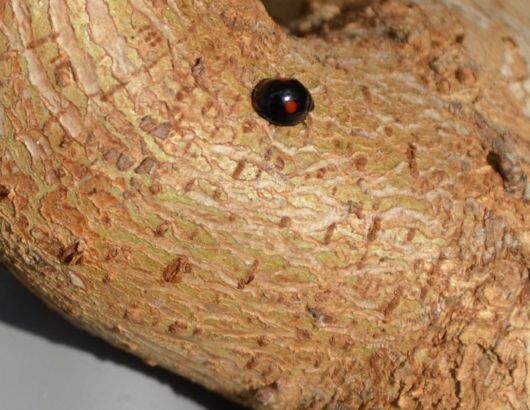 This insect was discovered on the 1 inch diameter (25.4 mm) trunk of a Manitoba maple tree which in turn was growing up through a peach tree.
This insect was discovered on the 1 inch diameter (25.4 mm) trunk of a Manitoba maple tree which in turn was growing up through a peach tree.
The ladybug was walking in that sort-of roman key pattern of tiny squares. It’s probably to make sure they don’t miss any food as they search along the branch or leaf. There were some leaf-sapping brown spots on the maple leaves. Maybe they were home to some kind of edible insect.
This was a very tiny beetle, literally only the size of a regular sewing pin top, not even one of those fancier pins with the coloured tops. The shape was almost perfectly round to look at from above.
A bit of research on the internet uncovered there are 4 black ladybugs with red spots in North America.
Thalassa monetzumae, the Montezuma Lady Beetle
The Montezuma Lady beetle is only native in Arizona and Texas south to South America, although it has been introduced to Florida. So it’s highly unlikely that my little predator was Montezuman. Good thing, too, as I don’t want to face any Montezuma’s Revenge!
Harmonia axyridis, the Multicolored Asian Lady Beetle
These ladybugs are the most common ones around here these days. A few years ago we had a population explosion of them when the maple aphids had a bumper year. I know what they look like, and this wasn’t one.
You may be thinking, aren’t those Asian ones orangey-yellow with lots of black spots? Yes, usually they are. However, they do come in a reverse colour pattern.
Another deciding factor will be discussed below.
Adalia bipunctata, the Two Spotted Lady Beetle
At first glance, this was a contender. Two-Spots are 3.5 – 5.2mm in length as adults. In its rarer form, it can be mostly black with 0-10 spots.
However, its range in North America has been shrinking rapidly and it is actually expected to soon disappear from most of its range. While I’d like to think I’d seen a really rare insect, I always have doubts if there is a common insect that it could be.
And then I noticed that the Two Spotted Lady Beetle has noticeable white markings on its, um, face. Or what I call its face, anyway. The experts call it the pronotum. There was not really any noticeable white on the face of my ladybug.
That left me with one strong contender:
Chilocorus stigma, the Twice Stabbed Lady Beetle
The Twice-Stabbed looks the most like the one I saw. Like the Two-Spots, the size seemed reasonable at 3.75 to 5 mm for an adult. Another person’s ladybug was confirmed as a Chilocorus stigma, and she had commented in her description, “I’ve never seen such a TINY beetle before.” Sounds familiar to me!
Its range is widespread, including all of Canada east of the Rockies.
Another ladybug expert mentioned this type has a strong “rim” around the elytra. Mine seems to have that too.
And there is very little white on the “face” or protonum of the Twice-Stabbed.
Regrets
My only regret is that I never flipped my beetle over. I generally try not to “bug” (ha, ha, so witty) anything I’m observing, so it never occurred to me. Apparently, though, the underside is a good clue to some types of ladybugs. For examples, you can look at: http://bugguide.net/node/view/372 . So next time, I’ll be more rude, and inspect the beetles nether regions.
So my conclusion is that I discovered a Chilocorus stigma, or Twice Stabbed Lady Beetle. Although I swear I never stabbed it at all, much less twice.
Join In
Have you ever found one of these polka-dotted black beetles? What was it prowling around at the time? Or do you dispute my detective work? Please share your observations and opinions with a comment.
